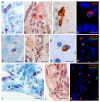Space-Flight- and Microgravity-Dependent Alteration of Mast Cell Population and Protease Expression in Digestive Organs of Mongolian Gerbils
- PMID: 37686410
- PMCID: PMC10488096
- DOI: 10.3390/ijms241713604
Space-Flight- and Microgravity-Dependent Alteration of Mast Cell Population and Protease Expression in Digestive Organs of Mongolian Gerbils
Abstract
Mast cell (MC)-specific proteases are of particular interest for space biology and medicine due to their biological activity in regulating targets of a specific tissue microenvironment. MC tryptase and chymase obtain the ability to remodel connective tissue through direct and indirect mechanisms. Yet, MC-specific protease expression under space flight conditions has not been adequately investigated. Using immunohistochemical stainings, we analyzed in this study the protease profile of the jejunal, gastric, and hepatic MC populations in three groups of Mongolian gerbils-vivarium control, synchronous experiment, and 12-day orbital flight on the Foton-M3 spacecraft-and in two groups-vivarium control and anti-orthostatic suspension-included in the experiment simulating effects of weightlessness in the ground-based conditions. After a space flight, there was a decreased number of MCs in the studied organs combined with an increased proportion of chymase-positive MCs and MCs with a simultaneous content of tryptase and chymase; the secretion of specific proteases into the extracellular matrix increased. These changes in the expression of proteases were observed both in the mucosal and connective tissue MC subpopulations of the stomach and jejunum. Notably, the relative content of tryptase-positive MCs in the studied organs of the digestive system decreased. Space flight conditions simulated in the synchronous experiment caused no similar significant changes in the protease profile of MC populations. The space flight conditions resulted in an increased chymase expression combined with a decreased total number of protease-positive MCs, apparently due to participating in the processes of extracellular matrix remodeling and regulating the state of the cardiovascular system.
Keywords: Mongolian gerbils; chymase; mast cells; space flight; the digestive system; tryptase.
Conflict of interest statement
The authors declare no conflict of interest.
Figures



References
MeSH terms
Substances
LinkOut - more resources
Full Text Sources

